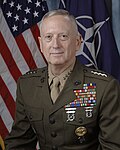Bronze Star Medal
The Bronze Star Medal is the fourth-highest individual military award. It is the ninth-highest award by order of precedence in the US Military. It may be awarded for acts of heroism, acts of merit, or meritorious service in a combat zone. When it is awarded for acts of heroism, the medal is awarded with the "V" device attached. The required acts are less heroic than those that qualify for the Silver Star.
Eligibility
The medal is sometimes called the Bronze Star. Foreign soldiers,[1] as well as officers from the other federal uniformed services are also eligible to receive the decoration. They must be serving with a service branch of the United States Armed Forces.[2]
History
The Bronze Star Medal was an idea by Colonel Russell P. "Red" Reeder in 1943. He believed it would aid morale if there was a medal which could be awarded by captains of companies or batteries to deserving people serving under them. Reeder felt another medal was needed for ground forces that was equivalent to the Air Medal. He proposed that the new award be called the "Ground Medal".[3] The idea eventually gained support. General George C. Marshall wrote a memorandum (note) to President Franklin D. Roosevelt dated 3 February 1944. He wrote:
| “ | The fact that the ground troops, Infantry in particular, lead miserable lives of extreme discomfort and are the ones who must close in personal combat with the enemy, makes the maintenance of their morale of great importance. The award of the Air Medal has had an adverse reaction on the ground troops, particularly the Infantry Riflemen who are now suffering the heaviest losses, air or ground, in the Army, and enduring the greatest hardships. | ” |
The Air Medal had been adopted two years earlier to raise airmen's morale. President Roosevelt authorized the Bronze Star Medal by Executive Order 9419 dated 4 February 1944. The order was made retroactive to 7 December 1941. The Executive Order was amended by President John F. Kennedy. The Executive Order 11046 dated 24 August 1962 expanded the authorization to include those serving with friendly forces. This allowed for awards where US service members might be involved in an armed conflict where the United States was not a belligerent. At the time of the Executive Order the US was not a belligerent in Vietnam. So any US advisers serving with the Republic of Vietnam Armed Forces would not have been eligible for the award.
A study was conducted in 1947. The outcome was the policy was changed to make the retroactive award of the Bronze Star Medal (without the "V" device) to all soldiers who had received the Combat Infantryman Badge. It also included those who received the Combat Medical Badge during World War II. The reason for doing this was that the badges were awarded to soldiers who experienced the hardships described in General Marshall's memorandum. Both badges required a recommendation by the commander and a citation in orders.
Order of Precedence
The Bronze Star is worn on the uniform after the Soldier's Medal or the Airman's Medal.[4] It is to be worn before the Purple Heart.[4] When a second (or more) award is given for the Silver Star, an oak leaf cluster is added to the ribbon.[4] The "V" device (for valor) is worn on the center of the ribbon. Any oak leaf clusters are worn to the right or left of the "V".[4]
Bronze Star Medal Media
Marine Col. Richard E. Edgington after being awarded a Bronze Star
References
- ↑ Australian officer awarded US Bronze Star. 16 March 2005. http://www.theage.com.au/news/Iraq/Australian-officer-awarded-US-Bronze-Star/2005/03/16/1110913663321.html. Retrieved 7 December 2012.
- ↑ "PHS Officer Awarded Bronze Star for Year Long Deployment in Afghanistan". Commissioned Officers Association of the USPHS Inc.. 22 July 2009. http://www.coausphs.org/news.cfm. Retrieved 12 December 2009.
- ↑ Reeder, Colonel Red. Born at Reveille. New York: Duell, Sloan and Pearce (1966), page 218.
- ↑ 4.0 4.1 4.2 4.3 Fred L. Borch III, Medals for Soldiers and Airmen: Awards and Decorations of the United States (Jefferson, NC: McFarland & Company, Inc., Publishers, 2013), pp. 90–91




